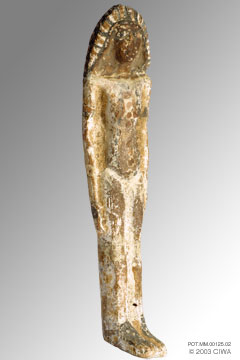Funerary female statuette, Dyn. 4-13

Links to other views:⇒ Larger Viewif scripting is off, click the ⇒ instead. Links to others of type Human figurineFaience figurine of a king striding, Dyn. 22 |
This clay statuette wears a translucent dress adorned from shoulders to feet with columns of large red dots. Both arms are firmly extended along her sides. She wears an unusual type of headdress—a large covering striped black, white, and brown. Her oval face, painted reddish brown, is dominated by immense eyes, wide open in a fixed stare. Female statuettes with hands and arms extended straight against their sides, nude or sometimes dressed, have been discovered dating from Dynasty 4 onward through the late Middle Kingdom. This artifact does not appear to be a fertility figurine, nor an offering-bearer. Is she the representation of a dead female buried in her own tomb? Perhaps, but her terrified facial expression is unusual and terribly disturbing—not that of someone looking forward to eternal bliss. Could she be an archaic sacrificed retainer buried with her royal master or mistress ? This object is mute to our questioning. The place where this pottery was excavated is unknown to us, and the unusual headdress does not match anything in our documentation. Her origin and function are, therefore, very speculative. Female funerary statuettes, which are not to be confused with shawabtis or shabtis, have been excavated from tombs anterior to Dynasty 12 of the Middle Kingdom, when the archaic shawabtis first appeared. “Some of the earliest examples, associated with women’s burials of the Herakleopolitan period (Dynasties 9-10) are female-shaped” (Capel 1996:148). “Like the so-called paddle dolls, female faience figurines have often been described as ‘concubines of the dead’, that is, as sexual accessories for dead men. . . .By no means made exclusively as funerary equipment for men, they have been found in temples and in burials of women and children. . . Unlike the paddle-dolls, which have neither feet nor legs and sometimes no arms, the faience figurines have truncated, stumpy legs” (Capel 1996:64). “From at least the Badarian period onwards, figurines of women made of clay, wood, ivory or stone, were included among funerary equipment. They were often highly stylized and generally emphasized one or more of the sexual characteristics. The interpretation of the various different types of ‘fertility figurines’ has proved extremely difficult. Two areas of confusion have persisted until recent times: on one hand, some figures were described by their excavators as ‘dolls’ and therefore incorrectly viewed as toys; on the other hand, even when their sexual significance was recognized by scholars, they were often automatically assumed to have been intended for the posthumous sexual gratification of the deceased (despite the fact that they have been found in the tombs of women as well as men). It is now believed by most Egyptologists that the function of such female figurines within the tomb was to reinforce or symbolize the sexual aspects of regeneration and rebirth” (Shaw and Nicholson 1995:265-266). “One reason for the somewhat sinister reputation which the earliest Kings of Egypt seem to have borne in the minds of the later generations may have been associated with the cult of ritual death. . . There is the undoubted fact that the kings of the First Dynasty, and a number of the Second, took with them companies of retainers who were sacrificed and buried with their royal master or, sometimes mistress. . . There is no doubt that these interments took place at the same time as the principal was laid in his tomb; the same mound usually covers them all. Sometimes the occupants of the subsidiary graves were courtiers or undifferentiated attendants of the king. In some cases they were craftsmen and specialists who might continue to provide their master with their eternal services. . . The practice of the immolation of servants was eventually discontinued; by the end of the Second Dynasty it had attenuated and was allowed to fall into disuse” (Rice 1991:129,130). Bibliography (for this item)Capel, Anne K., and Glenn E. Markoe1996 Mistress of the House, Mistress of Heaven: Women in Ancient Egypt. Hudson Hills Press, New York, NY. (64, 148) Khalil, Hassan M. 1976 Preliminary Studies on the Sanusret Collection. Manuscript, Musée l’Egypte et le Monde Antique, Monaco-Ville, Monaco. ([Blue] #175 [III] 337-339) Rice, Michael 1991 Egypt’s Making: The Origin’s of Ancient Egypt, 5000-2000 B.C.. Routledge, New York, NY. (129, 130) Robins, Gay 1993 Women in Ancient Egypt. Harvard University Press, Cambridge, MA. Shaw, Ian, and Paul Nicholson 1995 The Dictionary of Ancient Egypt. British Museum Press, London, United Kingdom. (265-266) Vandier, J 1958 Manuel d’Archeologie Egyptienne. Tome III: Les grandes époques—la statuaire. A. et J. Picard, Paris, France. |